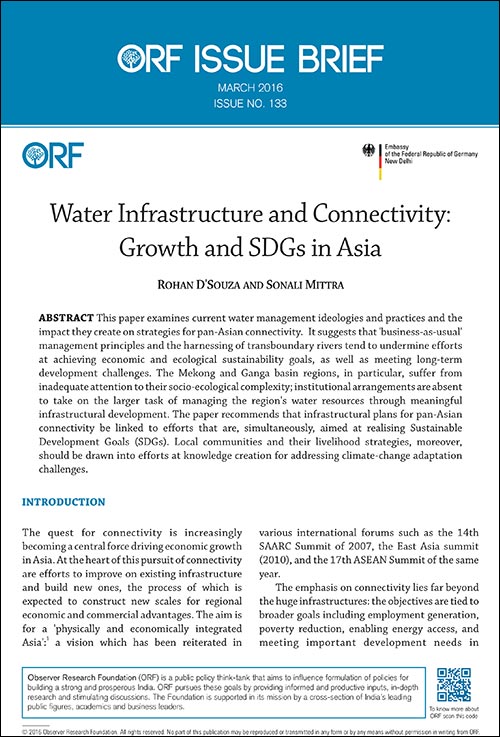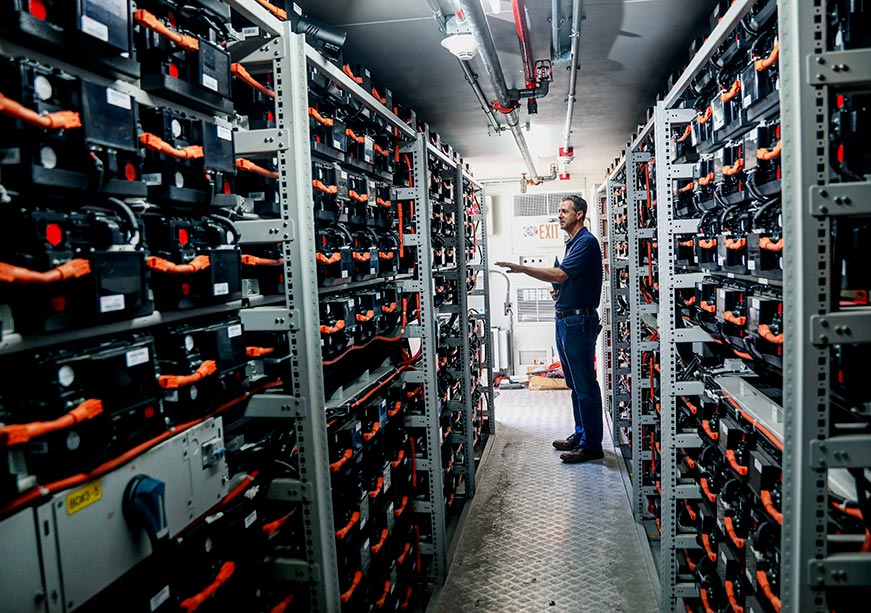INTRODUCTION
The quest for connectivity is increasingly becoming a central force driving economic growth in Asia. At the heart of this pursuit of connectivity are efforts to improve on existing infrastructure and build new ones, the process of which is expected to construct new scales for regional economic and commercial advantages. The aim is for a 'physically and economically integrated Asia'1: a vision which has been reiterated in various international forums such as the 14th SAARC Summit of 2007, the East Asia summit (2010), and the 17th ASEAN Summit of the same year.
The emphasis on connectivity lies far beyond the huge infrastructures: the objectives are tied to broader goals including employment generation, poverty reduction, enabling energy access, and meeting important development needs in sanitation, health, and education. Achieving mitigation targets to respond to climate change commitments is another crucial expectation from initiatives for connectivity.
While the challenges facing countries across Asia have their own peculiarities, there are overarching imperatives that are shared across the continent and which policymakers and state administrators must address. First, how meaningfully regional and national connectivity initiatives can be aligned to the recently formulated Sustainable Development Goals (SDGs).2,3 Second, how the Paris Agreements on climate change can be incorporated while meeting infrastructural targets.4 And third, how water requirements and, notably, managing transboundary rivers across Asia will be met in the pursuit of connectivity.5
The costs are undoubtedly enormous for the Asian connectivity project, and they cover not only the obvious financial and technical aspects but, equally important, environmental and social ones, too. These implications will require multifaceted approaches. A figure of US$ 8 trillion is being calculated as the approximate investment required for funding Asian infrastructure projects comprising energ y, telecommunication, transport, water, and sanitation.6 Connectivity by road alone, for example, will account for almost US$ 70 billion, of which US$ 48 billion is expected to come from the private sector.7 Determining the source of these funds-and managing them-is amongst the daunting tasks ahead. The other tasks are equally formidable, such as addressing profound environmental questions while harnessing natural resources. Further, there is the need to respond to a range of geopolitical concerns, including the following: a) issues of national sovereignty; b) rights and entitlements to common pool resources; and c) cooperation for transboundary river resources.
This paper describes cur rent water management ideologies and practices, and their potential impact on the success and sustainability of a pan-Asian connectivity, albeit, so far only imagined. This paper defines 'pan-Asia' to mean Southeast and South Asia - two regions that encompass some of the world's richest and pristine natural resources, such as river systems, lands, forests, and mineral deposits. On these huge swathes of land are dependent entire communities-connected to nature for their very survival, tied by their histories and cultures.
The pan-Asian countries are part of several regional groupings such as the South Asian Association for Regional Cooperation (SAARC), Association of Southeast Asian Nations (ASEAN), Bay of Bengal Initiative for Multi-Sectoral Technical and Economic Cooperation (BIMSTEC), Bangladesh, Bhutan, India, Nepal Initiative (BBIN), and the the Bangladesh-China-India-Myanmar Forum for Regional Cooperation (BCIM). In recent years, however, much of the impetus in pan-Asia for infrastructure development, employment generation, and institution building, draws specifically from two regions within: the ASEAN and the Indian subcontinent. Both these regions are highly defined by some of the world's most sensitive river ecosystems: the Mekong and Ganga river basins, whose significance can be gauged from the fact that they sprawl across vast flood plains that are inhabited by a vast number of communities who are dependent on the products of these ecosystems. The fact that the 'Mekong-Ganga' serves as the name for the official cooperation (as part of India's Look East Policy) between the six Mekong countries and India, is no mere coincidence; rather, it is proof of the high regard that has historically been accorded the two rivers. Over the years, the Mekong countries- Thailand, Cambodia, Lao PDR, Myanmar, Vietnam, and China-and the Ganga countries of Nepal, India and Bangladesh, have converged in their interest to meet developmental goals and manage transboundary water resources.
This paper probes the water management potentials of, and links between, the Mekong countries (as a sub-set of ASEAN) and India (as representative for the Ganga River system).
THE MAKING OF THE MEKONG-GANGA COOPERATION (MGC)
Pan-Asian connectivity is not entirely a new vision; there are historical references in the literature to some of the oldest cultural and economic links between the Mekong-Ganga regions and their empires. India started its engagement with the ASEAN as part of its Look East Policy formulated in the latter part of the 1990s. As the final dialogue partner of the ASEAN summit in 2002, India signed the Free Trade Area agreement in 2009, and became a full-fledged strategic partner of the ASEAN in 2012: meaning, that India agreed to cooperate with the association in various economic, cultural, political, and security fields.8
The Master Plan on ASEAN Connectivity, formulated during the 17th ASEAN Summit in Hanoi in 2010, placed emphasis on improving connectivity with China, India, and other neighbours by way of increasing physical, institutional, and people-to-people capacities.9 India viewed the ASEAN-India connectivity as a matter of strategic importance and in 2013 became the third dialogue partner in the discussions on road, air, maritime connectivity and possibly for economic corridors as well. Over the past 20 years, ASEAN and India have been actively collaborating in the sectors of agriculture, science and technology, space, environment, and 10 climate change.
Absent so far is a more focused collaboration between India and countries in the Southeast Asia that encompasses transboundary rivers, in spite of the initiation of the Mekong-Ganga Cooperation.11 Tentative efforts at cooperation began in the early 2000s with the Ganga-Mekong Suvarnbhumi Programme (GMSP); dialogues were initiated on the margins of the ASEAN Post- Ministerial conference to improve cultural and commercial linkages between the two regions. Earlier, the Vientiane Declaration helped launch the groundwork for the official Mekong-Ganga Cooperation, envisioned to jumpstart social, economic, cultural and sustainable development projects in the Ganga and Mekong countries.
On connectivity, the MGC has taken huge initial steps with the ongoing development of the India-Myanmar-Thailand Trilateral Highway project and its extension into Cambodia and Lao PDR. The project, though, has since gotten stalled because of various issues, such as the need to examine and rehabilitate distressed bridges on the Irrawaddy River.12 There are also discussions on creating a Mekong-India Economic Corridor which can link peninsular India with the Greater Mekong sub-region through a sea link to remove supply-side bottlenecks and improve trade.13 The different governments across the region view the ongoing projects as a step forward in the direction of greater connectivity. Progress on the ground, however, has been slow: poorly understood socio-ecological contexts have undermined many of the investments, preventing positive outcomes. Several Indian infrastructure projects-such as large dams, highways, chemical factories, and manufacturing bases-are facing financial overruns on account of unresolved issues of land acquisition, inadequate resettlement and rehabilitation policies, improper environmental assessments, and, in some cases, intense local agitation. These cases have proven that business-as-usual attitudes towards socio-environmental concerns are inadequate. Prospective infrastructure projects will need to be reconsidered with a fresh look at cost-benefit accounting procedures and capacities for negotiating aspects such as compensation. The challenge will be even more complex in projects involving the development of waterrelated infrastr uctures and har nessing transboundary rivers: the success of these projects depends on how such investments are made to align with larger SDGs.
WATER MANAGEMENT IN MEKONG AND GANGA COUNTRIES
The Ganga river system sprawls across its vast flood plains by linking and entwining within the breadth of its flows, three sovereign political units: Nepal, India, and Bangladesh. By threading these distinct political territories, the Ganga system has inadvertently also become the source for intense debates revolving around river benefits, ownership, entitlements, and the stillunder- defined terrain of legal jurisdiction. For nearly half a century, a series of agreements, treaties and understandings have sought to apportion the variable waters that have coursed through the main stem of the Ganga system and its many tributaries and distributaries. These agreements have been weak, and they have failed due to the complex dynamics that characterise the relations between the countries of the South Asian continent.
The Ganga, known for its singular cultural siginificance, has s e en an ex p onentional development of its basin. Long before the colonial period, the Ganga basinwith its combined agricultural fertility and allure for human settlementhas been one of the region's most lucrative and attractive sites for development. At present, there are more than 47 major and medium irrigation projects operational in the 14 15 basin; 12 major storage and diversion projects; and 564 small, medium and large hydropower 16 projects. Fisheries resources in the basin have been massively explored and exploited, contributing a major portion to 1.04 percent 17 (fisheries and aquaculture) of GDP of India. Further, unabated urbanisation and industrialisation continue to exert immense pressure on the River, as do old infrastructure and quantitative engineering models of river management. There is an apparent disconnect between water policy, irrigation schemes, hydropower development plans, and fisheries management-and this is quite evident from the worsening environmental degradation of the 18 river and the declining productivity of its 19 ecosystem. It has not helped at all that the communities who are dependent on the river and its ecosystems remain mostly poor and continue to aspire for higher incomes, and in the process putting more pressure on the already fragile Ganga basin. This situation, sadly, is not unique to Ganga River. It is mirrored, to varying degrees, by the Mekong-that which is called, the 'sweet serpent' river of Southeast Asia.
The Mekong has been the object of various large-scale interventions, all of them driven by a compendium of economic and political motivations. These projects include the generation of hydropower, and the building of large networks of canals, embankments, and reservoirs. The social and environmental impacts of these water-control projects have only now begun to be understood, and moving forward on river development will require a strong recalibration over what constitutes meaningful benefits for the region. After all, the Mekong is a lifeblood for significant populations, with its sinuous stem cutting through not less than six countries in the southeast Asian region: China, Myanmar, Thailand, Lao PDR, Cambodia, and Vietnam. The Mekong is home to some of the most vulnerable and exotic ecosystems such as Tonle Sap, and such massive natural phenomenon 20 like the Naga fireballs. Following the thawing of the Cold War in the 1990s, there was a surge of infrastructural interventions for harnessing the economic potential of the Mekong in the form of canals, dikes, and hydropower. With aid from the US, Russia and multilateral development banks, four Mekong countries formed their first interregional committee in 1957 to promote and coordinate water resource development in the Lower Mekong Basin.21 Only 10 percent of the basin's hydropower potential has been tapped so far, and the average annual withdrawals for various uses of water is only 12 percent of Mekong's total annual discharge.22
Mekong countries have so far evolved more complex and mature institutional arrangements than what currently prevails amongst the Ganga basin countries. In particular, it is noteworthy that the regional development plan called the Mekong Master Development Plan provides for a sturdy institutional design setup in the form of the Mekong River Commission. The Ganga basin, on the other hand, has failed to nurture cooperation amongst its co-riparians, owing to various reasons that include not only strategic geopolitical calculations, but also economic asymmetries and historical disagreements. Despite the strongly dissimilar strategies for harnessing their rivers, the Mekong and Ganga basin members share common dilemmas over the pursuit of economic growth and sustainability.
While the rhetoric that has accompanied large water-control infrastructures was aimed at reducing poverty by fuelling economic growth in the Mekong and Ganga countries, the environmental sustainability of realising development outcomes from such interventions remains contested. In particular, many of the water infrastructure projects have resulted in community displacement, loss of livelihoods, and damage to ecosystems. Though the Mekong and Ganga basin countries are rapidly growing economies, they remain beset by massive poverty, with significant proportions of their populations lacking access to the most basic of services like water, sanitation, and energy. As if facing these challenges was not daunting enough, the Mekong and Ganga countries also must address the impacts of climate change. As climatic changes threaten to make water supply even more scarce where it should not be, these states will now be compelled to push for the development of large hydraulic structures to augment their water supplies.
A comparative investigation, for example, of the Uttarakhand hydropower projects in the Ganga basin and the Pak Mun Dam in Thailand, suggests how complex and yet similar the concerns can be. Shared understandings can thus become helpful. Several studies have been commissioned by the Indian government to review the proposal of cascading dams on the Alaknanda and Bhagirathi Rivers, which are tributaries of the Ganga River. Contrasting 23 reports by ITT Roorkee and the Wildlife 24 Institute of India on the environmental and social impacts of these dams resulted in intense disagreements between the government, civil society groups, local communities, and project developers. Eventually, the Supreme Court of India intervened and passed a decision scrapping 23 out of the 24 proposed projects on account of not only inadequate compensation strategies for the displaced population but also the probable 25 ecological damage. After the 2013 flash floods in Uttarakhanda massive disaster that claimed more than 5,000 livesthe lacunae in the planning process for large water projects were reviewed for their apparent insensitivity towards 26 ecological integrity and conservation. The report by the Government Expert Body headed by Dr Ravi Chopra (2014), Assessment of Environmental Degradation and Impact of Hydroelectric Project During the June 2013 Disaster in Uttarakhand, emphasised the urgent need to deal with the unpredictable impacts of climate and ecological responses that may be caused by developmental activities and the 27 exploitation of vulnerable natural systems.
The Pak Mun Dam in Thailand has also been the site of similarly adverse impacts on fluvial ecology, quickly generating different types of socio-economic stresses. To begin with, the number of people displaced due to the building of the dam far exceeded the calculations made 28 during the planning process. Moreover, a large number of households dependent on the river were adversely affected due to the decline in fish population. The compensation packages did not account for such indirect impacts and left communities even more vulnerable and povertystricken. This not only defied the supposed primary objective of improving quality of life through infrastructure development, but also put into question the process of decisionmaking.29 A series of conflicts then ensued as a result of the largely undemocratic decisionmaking processes, which further highlighted the importance of the politics of knowledge production and the socio-economic sensitivities around fisheries and livelihood loss in the basin. Consequently, proponents of similar projects have had to move to an alternative site and an institutional solution was sought to monitor and regulate strategies for meeting the concerns of the affected communities. This was a clear case of a development project exacting a higher cost than the promised benefit, casting adequate doubt on the effectiveness of traditional decisionmaking mechanisms for future water projects.
CONCLUSION
Can the vision for a connected pan-Asia-a highly ambitious one that desires an integrated economic and ecological region with enhanced physical connectivity, institutional commonalities, and people - to - people connections-help prepare its populations to deal with the threats of climate change and underdevelopment? The business-as-usual means of managing transboundary and domestic waters has proved to be neither encouraging nor sustainable for the long-term. This is true for both the Mekong and Ganga regions, which are bearing the brunt of inadequate socio-ecological planning while seeking to develop their water resources and infrastructure. While the Mekong basin countries could develop an integrated basin management plan and foster regional cooperation amongst its co-riparians,the Ganga basin countries have thus far failed to find a regional institutional solution to manage its waters. The plan to connect the two basins, along with the intermediary basins-the Brahmaputra, Irrawaddy, and Salween-would require a renewed approach and revision of the notion of 'development', and of the river itself. Existing techno-managerial tools for assessment, design, and operation of infrastructure will also prove insufficient unless socio-ecological concerns are meaningfully addressed in the planning process. New methods of knowledge production, mainstreaming minority voices, and rightful compensation to displaced communities will be central to the success of connectivity projects. Equally critical is the imperative for a careful and systematic effort at incorporating sustainable development goals in infrastructure programming: climate change mitigation and adaptation outcomes cannot be divorced from goals of economic connectivity and growth. If policymaking in the Mekong and Ganga basin countries continues to be led by the decades-old quantitative strategies for harnessing shared rivers without accommodating inclusive and participatory water development policies, then the ambitions of achieving regional connectivity may simply miss the mark.
ENDNOTES
1. Infrastructure for a Seamless Asia. Asian Development Bank, 2009.
2. In 2015, United Nations with support from 193 governments agreed to adopt 17 goals and 169 targets to achieve Sustainable Development. Second, how can the Paris Agreements on climate change be incorporated while meeting infrastructural targets.
3. Assembly, UN General. "Transforming our world: the 2030 Agenda for Sustainable Development." (Geneva: January 2015), 2015.
4. e Paris Agreement signed during COP 21 lays the groundwork for unprecedented global action for combating climate change collectively.
5. e Paris Agreement signed during COP 21 lays the groundwork for unprecedented global action for combating climate change collectively.
6. Tahalyani, Naveen, ' Asia's $1 trillion infrastructure opportunity' , Mckinsey Insights, 2011.
7. Geetanjali Nataraj, Infrastructure Challenges in India: e role of Public-Private Partnerships,: ORF Occasional Paper, February 2014.
8. Ministry of External Aairs. ASEAN-India Relations. Government of India. Available at: http://mea.gov.in/aseanindia/20-years.htm.
9. Association of Southeast Asian. Ha Noi Declaration on the Commemoration of the Fifth Anniversary of the East Asia Summit, Vietnam, 2010. Available at: http://www.asean.org/?static_post=ha-noideclaration- on-the-commemoration-of-the-fth-anniversary-of-the-east-asia-summit.
10. Ibid.
11. Ministry of External Aairs. Mekong-Ganga Cooperation (MGC). Government of India. Available at: http://mea.gov.in/aseanindia/about-mgc.htm.
12. De, Prabir. "Infrastructure development in India." International Infrastructure Development in East Asia-Towards Eective and Balanced Regional Integration. Economic Research Institute for ASEAN and East Asia (ERIA), 2007.
13. De, Prabir, and Kavita Iyengar. "Developing Economic Corridors in South Asia." 2014.
14. Ministry of Environment and Forests. Status Paper on River Ganga, National River Conservation Directorate. New-Delhi, India.2010.
15. National Institute of Hydrology 2010. Accessed on 15.08.2013. Available at : http://www.nih.ernet.in/rbis/india_information/irrigation%20demands.htm.
16. Central Water Commission. Water and Related Statistics. Water Resources Information System Directorate. Government of India. New-Delhi, India. 2010.
17. Ministry of Agriculture. Handbook on Fisheries Statistics. Department of Animal Husbandry, Dairying and Fisheries (DADH). Government of India. New-Delhi, India. 2011.
18. Ministry of Environment and Forests. Status Paper on River Ganga, National River Conservation Directorate. New-Delhi, India. 2009.
19. Ibid.
20. Cohen, Erik. "e" postmodernization" of a mythical event: Naga reballs on the Mekong river." Tourism Culture & Communication 7, no. 3.169-181. 2007.
21. Jacobs, Jerey W. "Mekong Committee history and lessons for river basin development." Geographical Journal (1995): 135-148.
22. Ringler, Claudia. Optimal water allocation in the Mekong River basin. No. 38. ZEF Discussion Papers on Development Policy, 2001.
23. AHEC, IIT Roorkee. Assessment of Cumulative Impact of Hydropower Projects in Alaknanda- Bhagirathi Basins. New Delhi: Ministry of Environment and Forests. 2010.
24. Rajvanshi, Asha, A. Roshni, V. B. Mathur, K. Sivakumar, S. Sathyakumar, G. S. Rawat, J. A. Johnson, K. Ramesh, N. K. Dimri, and Ajay Maletha. Assessment of cumulative impacts of hydroelectric projects on aquatic and terrestrial biodiversity in Alaknanda and Bhagirathi basins, Uttarakhand. Wildlife Institute of India. Technical Report, plus Appendices, 2012.
25. Supreme Court of India. AL AKNANDA HYDRO POWER CO. LTD. v ANUJ JOSHI [K .S. RADHAKRISHNAN, J.] 2013. Available at: http://supremecourtondia.nic.in/scr/2013/ 2013_v11_piii.pdf. Last accessed on 10 Jan 2016.
26. Sridharan, R. Tirtha Pratim Das, SM Ahmed, and Anil Bhardwaj. "Lessons from Kedarnath tragedy of Uttarakhand Himalaya, India." Current Science 105, no. 11 1472.2013.
27. Ministry of Environment and Forests. Assessment of Environmental Degradation and Impact of Hydroelectric Project During the June 2013 Disaster in Uttarakhand. Government of India. 2014.
28. Foran, Tira. "Rivers of contention: Pak Mun Dam, electricity planning, and statesociety relations in ailand, 19322004." PhD diss., University of Sydney, 2006.
29. Foran, Tira, and Kanokwan Manorom. "Pak Mun dam: perpetually contested." Contested waterscapes in the Mekong Region: Hydropower, livelihoods and governance: 55-80. 2009.
The views expressed above belong to the author(s). ORF research and analyses now available on Telegram! Click here to access our curated content — blogs, longforms and interviews.

 PDF Download
PDF Download



 PREV
PREV



